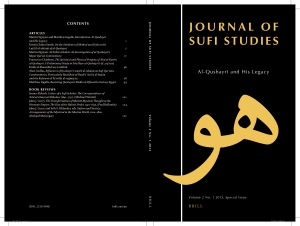In early 2010 Matthew Ingalls (University of Puget Sound) and I imagined a scholarly panel dedicated to the study of Abū l-Qāsim al-Qushayrī (d. 465/1072) and the legacy that he left behind that would appear at the American Academy of Religion. We contacted fellow scholars in the field and were able to convene such a session for the 2010 Annual Meeting of the American Academy of Religion (AAR), which met that year in Atlanta, Georgia. Afterwards we worked with Erik Ohlander, the Executive Editor of the Journal of Sufi Studies, to have these papers considered for a special issue of the journal. Following some years of work that issue has finally come to fruition. The special issue now features the revised and expanded versions of the papers first presented at the AAR as well as an introduction co-authored by Ingalls and myself.
More information on my article, which deals with the manuscripts possibly related to al-Qushayrī’s Major Qur’an Commentary, can now be found on the project page for al-Tafsīr al-kabīr.
The articles included in the JSS special issue on “Al-Qushayrī and His Legacy” are as follows:
Martin Nguyen and Matthew Ingalls, “Introduction: Al-Qushayrī and His Legacy” (p. 1-6)
Kristin Zahra Sands, “On the Subtleties of Method and Style in the Laṭāʾif al-ishārāt of al-Qushayrī” (p. 7-16)
Martin Nguyen, “Al-Tafsīr al-kabīr: An Investigation of al-Qushayrī’s Major Qur’an Commentary” (p. 17-45)
Francesco Chiabotti, “The Spiritual and Physical Progeny of ʿAbd al-Karīm al-Qushayrī: A Preliminary Study in Abū Naṣr al-Qushayrī’s (d. 514/1120) Kitāb al-Shawāhid wa-l-amthāl” (p. 46-77)
Alan Godlas, “Influences of al-Qushayrī’s Laṭāʾif al-ishārāt on Sufi Qur’anic Commentaries, Particularly Rūzbihān al-Baqlī’s ʿArāʾis al-bayān and the Kubrawi al-Taʾwīlāt al-najmiyya” (p. 78-92)
Matthew Ingalls, “Recasting al-Qushayrī’s Risāla in Fifteenth-Century Egypt” (p. 93-120)
The other articles in the special issue of the Journal of Sufi Studies may be accessed here.





